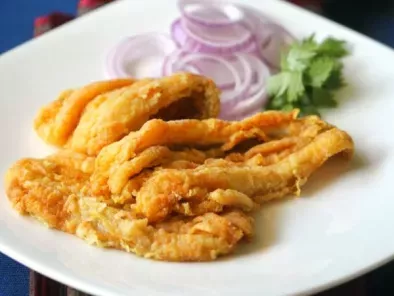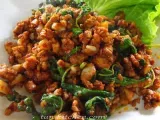Bombil Fry / Deep Fried Bombay Duck (Fish) ~ When The Hubby Cooks!

+-+1.jpg) Despite its name, the Bombay Duck is not a duck! It is a variety of fish that is found in the Arabian sea especially on the coast of Mumbai and Kutch (in Gujarat). Bombay duck is pretty popular in Mumbai (it has to be!) and is eaten both fresh and in its dried form (salted fish). There two forms of consuming this lovely fish are distinctly different from each other because of the way it smells. While the fresh fish has no odour (apart from a mildly fishy smell inherent to any seafood) or any distinctive taste (just a delicate flavour that takes any kind of marination well) the dried form is well, loved by some and hated by the rest. Although I love seafood of any sort (except for those which I am allergic to) I have a particular aversion to the dried Bombay duck as it smells like crazy! My friend in Mumbai once sent me a small portion of salted Bombay duck which she had prepared. It was her favourite she said.
Despite its name, the Bombay Duck is not a duck! It is a variety of fish that is found in the Arabian sea especially on the coast of Mumbai and Kutch (in Gujarat). Bombay duck is pretty popular in Mumbai (it has to be!) and is eaten both fresh and in its dried form (salted fish). There two forms of consuming this lovely fish are distinctly different from each other because of the way it smells. While the fresh fish has no odour (apart from a mildly fishy smell inherent to any seafood) or any distinctive taste (just a delicate flavour that takes any kind of marination well) the dried form is well, loved by some and hated by the rest. Although I love seafood of any sort (except for those which I am allergic to) I have a particular aversion to the dried Bombay duck as it smells like crazy! My friend in Mumbai once sent me a small portion of salted Bombay duck which she had prepared. It was her favourite she said. I never fathomed how terribly nauseous I would feel when the stink (or aroma if you please!) wafted towards my house from the lift/elevator area! Gosh! One look at it and into the bin it went. Sorry to those who just gasped that I wasted good food. In my defence, I normally never throw food away no matter how it tastes. But if it smells bad there's no way in hell I am going to eat it man! Ok, now that I sound sufficiently arrogant, let me continue with the etymology of the this fish!
+-+1.jpg)
Nobody knows the real reason behind its name. Why is it called the 'Bombay duck'? A bit of Googling brought me to this answer on Wikipedia which I quite liked and will go with until someone throws some more light on it. Apparently the shoals (groups) of fish around the Eurasian continent (combined landmass of Europe and Asia) were separated when the Indian plate moved into it (in short, parts of the land on planet Earth moved some donkey's years ago, like a million years ago and the current map of the world is what we see as a result of this). So basically the waters surrounding the Eurasian continent were divided by the land that is now called as India. The species of this fish was thus divided into what remained on the Western coast of India (around Mumbai and Kutch) and a small part of this fish can be found in eastern Bengal.
During the British Raj when the railways were formed, people in eastern Bengal were made aware of the great availability of the locally prized fish on India's western coast and hence they began importing them by the railways. When the dried fish was being transported by the railways its overpowering smell compelled them to later transport the consignment via the mail train, the Bombay Mail (or Bombay Daak). 'Daak' is the Hindi word for 'mail'. The Bombay Mail that reeked of the fish smell thus helped coin the popular term 'You smell like the Bombay Daak'. 'Bombay Daak' was eventually corrupted to 'Bombay duck'. Anyway, this theory is not supported by the Oxford English Dictionary which mentions the term 'Bombay duck' two years before the first railroad in Bombay was constructed. As per local Bangladeshi stories, the term Bombay duck was coined by Robert Clive who tasted this fish during his conquest of Bengal and associated its pungent smell with that of the newspapers and mail that would come into the cantonments from Bombay. If you ask me, I liked the first theory better than this, but since nobody really knows, lets just leave the name and move ahead with how the fish tastes. What's in a name after all eh?

-1.jpg)
+-2.jpg)
 Prep time: 15 mins (if you are using pre cleaned fish) | Marinating time: 30 mins | Frying time: 2 mins per batch | Serves 4
Prep time: 15 mins (if you are using pre cleaned fish) | Marinating time: 30 mins | Frying time: 2 mins per batch | Serves 4 Ingredients:9 or 10 Bombay ducks / BombilOil for deep fryingMarination:1 teaspoon chilli powder1/2 teaspoon turmeric powdersalt to taste2-3 teaspoons of lime juiceCoating:3/4th cup rice flour1 tablespoon corn flour (cornstarch)Method:1. Clean the fish well (but gently as it is soft) and place on a colander to drain off excess water. Then pat each piece of fish dry with an absorbent kitchen tissue or clean tea towel. Ensure that no water remains.
2. Marinate the fish with the chilli powder, turmeric powder, salt and lime juice and keep aside for half an hour.
3. After half an hour heat oil for deep frying in a wide and deep kadhai / wok. The oil should be really hot but not smoking. It is ideal to maintain the heat on a medium high. To test the readiness of the oil, drop a small ball of batter into the oil, if it comes up within 3-4 seconds with bubbles around it, the oil is ready.
4. In a large wide plate sift or mix the rice flour and cornstarch together. Place each piece of marinated fish on this mixture and pat gently so that it coats nicely on both sides.
5. Slide the fish, inner part first (stomach portion facing the oil first) into the hot oil. Add 1-2 pieces at a time to fry. Do not touch the fish for 25-30 seconds.
6. When extra moisture starts to evaporate from the fish and the coating turns light brown flip the fish and fry on the other side for roughly one minute. Each fish piece should be fried roughly for 2 minutes (both sides included).
7. Carefully remove the fish using a slotted spoon, drain excess oil from it into the pan and then place on an absorbent kitchen tissue. The fish should be crisp and firm.
8. Serve with steaming hot rice and curry or just as it is with green chutney.
Notes:1. The oil has to be at the right temperature for the fish to fry properly. Only then will it turn crisp. If the oil is not hot enough the fish will absorb excess oil. If the oil is too hot the outer covering/batter will get burnt quickly leaving the flesh uncooked. When in doubt, use a tiny piece of fish to test instead of frying a whole piece (don't waste!)
2. The bones/thorns are very delicate so there is no need to remove them while eating. The crispiness that deep frying provides makes it really easy to eat this fish as you can just bite, munch and swallow without bothering to pick out the bones. However, please be careful while serving this fish to small kids as they may not like to swallow the bones.
3. Always fry the fish when you are ready to serve. Deep fried foods are best eaten piping hot and fresh. When kept at room temperature for too long they can turn 'flat' and uncrispy (if there is such a word!)
Comments
Rate this recipe:
There are no comments!





